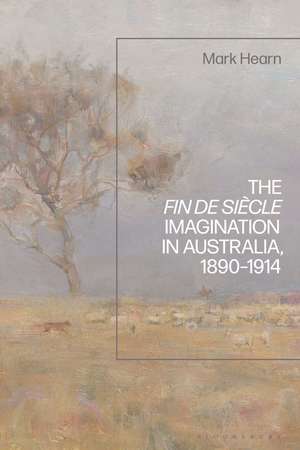The Fin de Siècle Imagination in Australia, 1890-1914
Autor Mark Hearnen Limba Engleză Paperback – 21 feb 2024
| Toate formatele și edițiile | Preț | Express |
|---|---|---|
| Paperback (1) | 191.67 lei 6-8 săpt. | |
| Bloomsbury Publishing – 21 feb 2024 | 191.67 lei 6-8 săpt. | |
| Hardback (1) | 539.99 lei 6-8 săpt. | +115.28 lei 7-11 zile |
| Bloomsbury Publishing – 10 aug 2022 | 539.99 lei 6-8 săpt. | +115.28 lei 7-11 zile |
Preț: 191.67 lei
Preț vechi: 249.53 lei
-23% Nou
Puncte Express: 288
Preț estimativ în valută:
36.68€ • 39.83$ • 30.81£
36.68€ • 39.83$ • 30.81£
Carte tipărită la comandă
Livrare economică 22 aprilie-06 mai
Preluare comenzi: 021 569.72.76
Specificații
ISBN-13: 9781350291423
ISBN-10: 1350291420
Pagini: 248
Ilustrații: 21 bw illus
Dimensiuni: 156 x 234 x 25 mm
Greutate: 0.35 kg
Editura: Bloomsbury Publishing
Colecția Bloomsbury Academic
Locul publicării:London, United Kingdom
ISBN-10: 1350291420
Pagini: 248
Ilustrații: 21 bw illus
Dimensiuni: 156 x 234 x 25 mm
Greutate: 0.35 kg
Editura: Bloomsbury Publishing
Colecția Bloomsbury Academic
Locul publicării:London, United Kingdom
Caracteristici
Studies the transnational exchange of ideas, social movements and the globalisation of culture and economic production at the turn of the 19th century
Notă biografică
Mark Hearn is Senior Lecturer of History and Archaeology at Macquarie University, Australia. The author of several books and scholarly articles in journals such as Gender and History, Rethinking History and National Identities, his research focuses on the history of ideas and governance in the late 19th and early 20th centuries.
Cuprins
List of IllustrationsAcknowledgementsIntroduction: Ends and Beginnings: Life and Mind at the Australian Fin de Siècle1. The Bush Undertaker: Henry Lawson and the Stragglers of the Second Industrial Revolution2. Rose Summerfield Imagines a New Woman3. The Wanderer: Christopher Brennan's Two Lives in Fin de Siècle Sydney4. 'A Modern Eve': Vida Goldstein Stands for Parliament5. 'Some Disquieting Symptoms': Alfred Deakin's Nervous Breakdown6. David Unaipon, 'The Super-Aborigine'7. John Dwyer's Family StoriesConclusion: Fin de Siècle Afterlife EndnotesBibliographyIndex
Recenzii
At last, the Australian experience of the extraordinarily volatile period known as the fin de siècle has found its historian. Carl Schorske first explained the significance of the era, and offered a brilliant model for understanding it, in his Fin-De-Siècle Vienna of 1979. Mark Hearn picks up where Schorske left off, amplifying his biographic structure and building on his profound insights. Hearn, though, has a theatre that adds the missing piece to the fin de siècle puzzle: a settler colonial site that shows how imperial forces drove many of the political and cultural crises of these crucial decades. Hearn's study includes women and Indigenous characters in with the more usual mix of male artists and European intellectuals. The result is an exemplary account for the twenty-first century.
Mark Hearn is the first historian to bring this important period in Australian cultural and political history - the 1890s - fully into the global history of modernity. Far from displaying an isolated colonial backwater, his study of seven emblematic lives of the fin de siècle gives us a unique insight into how leading Australian thinkers grappled with a modern world that was both accelerating and enervating. This is a fresh interpretation of a period that has long fascinated historians of Australia for its brew of nationalism, radicalism, utopianism and the occult, but it will interest anyone curious about how modern life reshaped imaginative possibilities at the same time as it generated new anxieties. This is a ground-breaking cultural history that invites us to rethink a formative era.
Mark Hearn is the first historian to bring this important period in Australian cultural and political history - the 1890s - fully into the global history of modernity. Far from displaying an isolated colonial backwater, his study of seven emblematic lives of the fin de siècle gives us a unique insight into how leading Australian thinkers grappled with a modern world that was both accelerating and enervating. This is a fresh interpretation of a period that has long fascinated historians of Australia for its brew of nationalism, radicalism, utopianism and the occult, but it will interest anyone curious about how modern life reshaped imaginative possibilities at the same time as it generated new anxieties. This is a ground-breaking cultural history that invites us to rethink a formative era.
